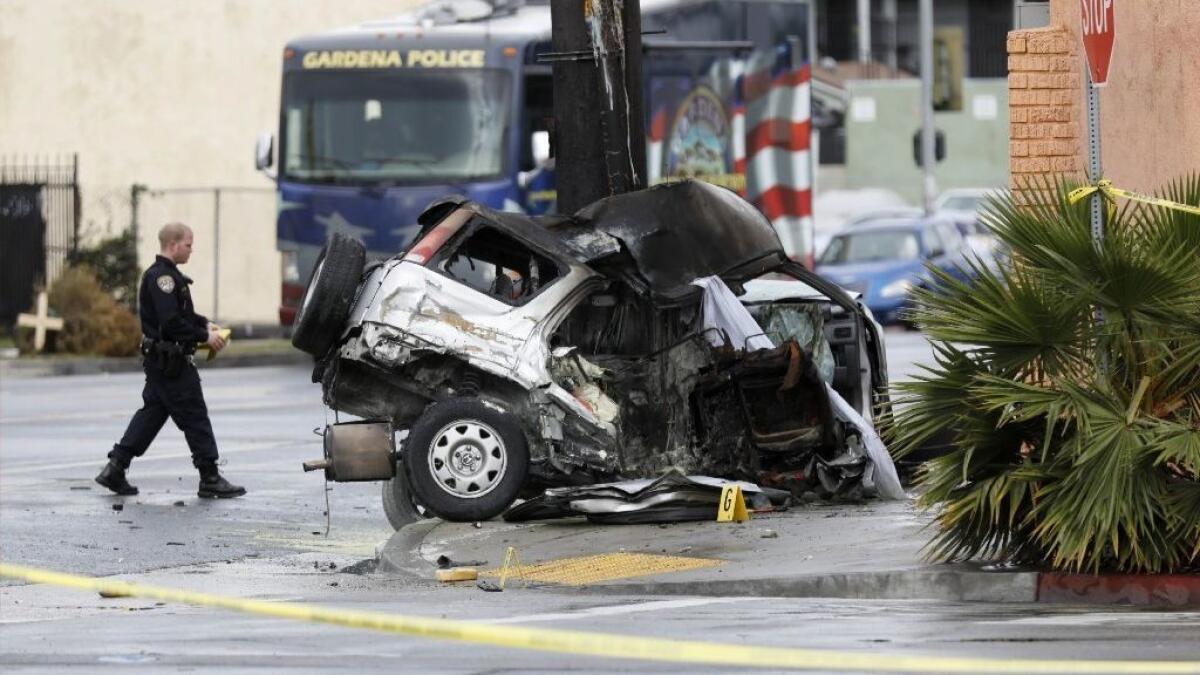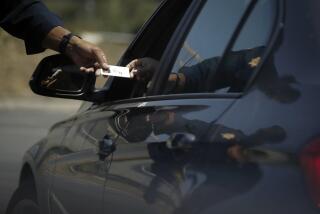California’s top court to decide what officers must do to escape liability in pursuit accidents

Three years ago, a Gardena police car chased a pickup truck being driven by someone who officers suspected had just stolen two cellphones at gunpoint.
It was nearly 11:30 p.m. on a Sunday, and there was little traffic in the industrial neighborhood.
Just over a minute after the pursuit began, a Gardena police officer driving nearly 50 mph rammed the truck in an attempted PIT maneuver, a pursuit tactic intended to force a fleeing car to turn sideways and stop. The maneuver is considered potentially lethal at speeds of more than 35 mph.
Mark Gamar, 19, a passenger in the truck, was killed, and his mother, Irma Ramirez, sued the Gardena Police Department.
The California Supreme Court will soon decide whether the lawsuit can go forward or whether the Gardena Police Department has immunity because it has a pursuit policy and provides regular training for its officers.
The case is being closely watched by law enforcement and safety advocates. If the court rules for Ramirez, people hurt and families of those killed during police pursuits will be more likely to win compensation from cities and counties.
A question of risk
Police chases in California regularly lead to injuries and deaths, causing some to question whether they are worth the risk to the public. Roughly 25% of all pursuits end in collisions, according to the California Highway Patrol. In 2016, police pursuits caused 762 injuries and 24 deaths. On average, there are 23 police chases a day in California.
State lawmakers over the past two decades have struggled to find ways to protect local governments from huge jury awards or settlements in pursuit cases and at the same time heed calls for making chases safer.
For a while, state law gave all peace officers complete immunity from suits if their agencies had a pursuit policy. But as lives continued to be lost, clamor to end the legal protections for law enforcement grew.
In 2002, “Kristie” Marie Elena Priano, 15, an honors student from Chico, died after her family’s minivan was hit by a car fleeing police. The driver of the other car was 15, and her mother had reported to police that she had taken the car without permission.
Pressed by Kristie’s family, legislators repeatedly introduced a bill to bar immunity for police unless certain procedures were established to reduce death and injuries to third parties. Kristie’s Law, as the bill was dubbed, failed to win passage.
In 2002, a Santa Ana-based state court of appeal wrote in a pursuit case that giving police immunity from suits for merely having a written pursuit policy was “cold comfort to victims.”
“We urge the Legislature to revisit this statute and seriously reconsider the balance between public entity immunity and public safety,” the three-judge panel wrote, throwing out a lawsuit by a victim of a pursuit.
“The balance appears to have shifted too far toward immunity and left public safety, as well as compensation for innocent victims, twisting in the wind,” the court said.
Chases on the rise statewide
In 2005, a bill was introduced in Sacramento to tighten the immunity law. The revisions went into effect in 2007, requiring all peace officers to certify that they read and understood the pursuit policy, as well as mandating annual training for officers.
Pursuits across California dipped each year from 2005 to 2010, records show.
But chases across the state have risen during the past four years, jumping from 6,731 in 2014 to 8,955 last year, a surge of about 33%, according to a Times analysis of data maintained by the California Highway Patrol. The number of injuries sustained during those chases has risen by 31% during the same time frame.
Last year, a grand jury in Los Angeles County openly questioned the dangers posed by pursuits led by the Los Angeles police and sheriff’s departments. In 2016, a Times analysis found that LAPD pursuits injured bystanders at more than twice the rate of other chases in the state.
Two years ago, a state court of appeal in San Diego allowed family members of a man killed during a police chase to sue the Beaumont Police Department.
The court said Beaumont had not “promulgated” its pursuit policy because not all officers had certified that they had read and understood it.
Rebecca L. Reed, who represented the family of the victim, who was killed when the fleeing suspect ran into his car, said Beaumont settled the case for $999,999.
She now has four other cases pending on behalf of people who were injured or killed during police pursuits.
In the Gardena case, a Los Angeles-based court of appeal decided last year that 100% officer certification was not necessary for a police department to retain immunity, setting up a conflict that the California Supreme Court now must resolve.
About 10% of Gardena’s officers had not certified that they read and understood the pursuit policy in the year prior to the deadly chase.
Is 100% compliance required?
Gardena argued that the law gives departments immunity as long as they require all officers to certify and train, even if 100% of the force has not complied.
Law enforcement argues that requiring 100% compliance would be impossible, especially for large agencies like the LAPD and the Los Angeles County Sheriff’s Department, which each roster about 10,000 officers.
Officers may be on leaves of absence for medical or family reasons or deployed to the military, making them unavailable for training, an association of law enforcement groups told the state high court in written arguments.
During a hearing before the court last month, at least three of the court’s seven justices echoed similar concerns.
Abdalla J. Innabi, who is representing the mother of the victim in the Gardena case, said police simply don’t want “the administrative hassle” of ensuring all officers have certified.
In return for gaining 100% compliance, a department will have immunity even if an officer behaved egregiously and caused enormous harm, Innabi noted.
Some police experts who have studied pursuits believe the degree of immunity California grants to its police officers is out of balance with public safety concerns.
“If you don’t follow the policy, how good is the policy? The issue is important to make sure that officers do what they’re supposed to,” said Geoff Alpert, a professor of criminology at the University of South Carolina.
A national study by the International Assn. of Chiefs of Police found that 91% of high-speed chases began in response to nonviolent crimes and 42% involved traffic infractions.
Stricter chase policies in some cities
Because of the risks, some police departments, including those in San Francisco, Long Beach and San Jose, allow officers to chase only suspects who present an immediate danger to the public or are believed to have committed violent felonies.
The Gardena pursuit began in a response to a report that cellphones had been taken at gunpoint. The driver of the pickup was later convicted of the robbery, and a shotgun was found next to Gamar.
The officer who rammed the truck said he did so because he believed it was about to enter a freeway going the wrong way. Innabi said the evidence does not support that contention.
Gardena declined to allow its lawyers to be interviewed, releasing a statement saying it “remains dedicated to the proper training of its officers” and expressing confidence that the California Supreme Court will rule in its favor.
A ruling is expected by the end of summer, but Alpert said California law already has created a situation where police are more likely to get into dangerous car chases over minor offenses.
“There are two reasons why you restrict pursuits: One is public safety and one is financial exposure,” he said. “So if you remove the financial exposure as a deterrent, then all you have left is public safety and that is going to vary by the quality of the command staff and the quality of the chief.”
maura.dolan@latimes.com | Twitter: @mauradolan
james.queally@latimes.com | Twitter: @JamesQueallyLAT
More to Read
Start your day right
Sign up for Essential California for news, features and recommendations from the L.A. Times and beyond in your inbox six days a week.
You may occasionally receive promotional content from the Los Angeles Times.








